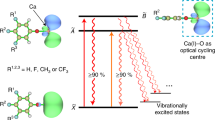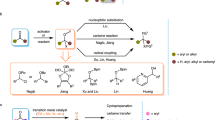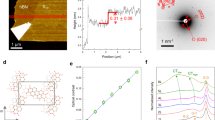Abstract
Molecules capable of repeatable, narrow-band spontaneous photon scattering are prized for direct laser cooling and quantum state detection. Recently, large molecules incorporating phenyl rings have been shown to exhibit a high probability of returning to the same vibrational state after photon emission, a behaviour previously observed in small molecules, although it is not yet known if the high vibrational-mode density of even larger species will eventually compromise optical cycling. Here we systematically increase the size of hydrocarbon ligands attached to single alkaline-earth phenoxides from –H to –C14H19 while measuring the vibrational branching fractions of the optical transition. We find that varying the ligand size from one to more than 30 atoms does not systematically reduce the cycle closure, which remains around 90%. Theoretical extensions to larger diamondoids and diamond surfaces suggest that alkaline-earth phenoxides may maintain their desirable scattering behaviour as the system size grows further, with no indication of an upper limit.

This is a preview of subscription content, access via your institution
Access options
Access Nature and 54 other Nature Portfolio journals
Get Nature+, our best-value online-access subscription
$32.99 / 30 days
cancel any time
Subscribe to this journal
Receive 12 print issues and online access
$259.00 per year
only $21.58 per issue
Buy this article
- Purchase on SpringerLink
- Instant access to full article PDF
Prices may be subject to local taxes which are calculated during checkout





Similar content being viewed by others
Data availability
The datasets and codes for Figs. 2–5 and Extended Data Figs. 1 and 2 are available from Zenodo via https://doi.org/10.5281/zenodo.14496831. (ref. 72). All other data supporting the findings of this study are available in the Supplementary Information files. Source data are provided with this paper.
References
Krantz, P. et al. A quantum engineer’s guide to superconducting qubits. Appl. Phys. Rev. 6, 021318 (2019).
Zwanenburg, F. A. et al. Silicon quantum electronics. Rev. Mod. Phys. 85, 961 (2013).
Kaufman, A. M. & Ni, K.-K. Quantum science with optical tweezer arrays of ultracold atoms and molecules. Nat. Phys. 17, 1324–1333 (2021).
Bruzewicz, C. D., Chiaverini, J., McConnell, R. & Sage, J. M. Trapped-ion quantum computing: progress and challenges. Appl. Phys. Rev. 6, 021314 (2019).
Carr, L. D., DeMille, D., Krems, R. V. & Ye, J. Cold and ultracold molecules: science, technology and applications. New J. Phys. 11, 055049 (2009).
Albert, V. V., Covey, J. P. & Preskill, J. Robust encoding of a qubit in a molecule. Phys. Rev. X 10, 031050 (2020).
Jain, S. P., Hudson, E. R., Campbell, W. C. & Albert, V. V. Absorption–emission codes for atomic and molecular quantum information platforms. Phys. Rev. Lett. 133, 260601 (2024).
Isaev, T. A. & Berger, R. Polyatomic candidates for cooling of molecules with lasers from simple theoretical concepts. Phys. Rev. Lett. 116, 063006 (2016).
Kozyryev, I., Baum, L., Matsuda, K. & Doyle, J. M. Proposal for laser cooling of complex polyatomic molecules. ChemPhysChem 17, 3641–3648 (2016).
Augenbraun, B. L., Doyle, J. M., Zelevinsky, T. & Kozyryev, I. Molecular asymmetry and optical cycling: laser cooling asymmetric top molecules. Phys. Rev. X 10, 031022 (2020).
Dickerson, C. E. et al. Franck–Condon tuning of optical cycling centers by organic functionalization. Phys. Rev. Lett. 126, 123002 (2021).
Fitch, N & Tarbutt, M. in Advances in Atomic, Molecular, and Optical Physics Vol. 70 (eds Dimauro, L. F. et al.) 157–262 (Elsevier, 2021).
Vilas, N. B. et al. Magneto-optical trapping and sub-Doppler cooling of a polyatomic molecule. Nature 606, 70–74 (2022).
Augenbraun, B. L. et al. in Advances in Atomic, Molecular, and Optical Physics Vol. 72 (eds Dimauro, L. F. et al.) 89–182 (Elsevier, 2023).
Cheuk, L. W. et al. Λ-enhanced imaging of molecules in an optical trap. Phys. Rev. Lett. 121, 083201 (2018).
Shaw, J., Schnaubelt, J. & McCarron, D. Resonance Raman optical cycling for high-fidelity fluorescence detection of molecules. Phys. Rev. Res. 3, L042041 (2021).
Schlosser, N., Reymond, G., Protsenko, I. & Grangier, P. Sub-Poissonian loading of single atoms in a microscopic dipole trap. Nature 411, 1024–1027 (2001).
Anderegg, L. et al. An optical tweezer array of ultracold molecules. Science 365, 1156–1158 (2019).
Holland, C. M., Lu, Y. & Cheuk, L. W. Bichromatic imaging of single molecules in an optical tweezer array. Phys. Rev. Lett. 131, 053202 (2023).
Vilas, N. B. et al. An optical tweezer array of ultracold polyatomic molecules. Nature https://doi.org/10.1038/s41586-024-07199-1 (2024).
Holland, C. M., Lu, Y. & Cheuk, L. W. On-demand entanglement of molecules in a reconfigurable optical tweezer array. Science 382, 1143–1147 (2023).
Bao, Y. et al. Dipolar spin-exchange and entanglement between molecules in an optical tweezer array. Science 382, 1138–1143 (2023).
Campbell, W. C. & Hudson, E. R. Dipole–phonon quantum logic with trapped polar molecular ions. Phys. Rev. Lett. 125, 120501 (2020).
Hudson, E. R. & Campbell, W. C. Laserless quantum gates for electric dipoles in thermal motion. Phys. Rev. A 104, 042605 (2021).
Yu, P., Cheuk, L. W., Kozyryev, I. & Doyle, J. M. A scalable quantum computing platform using symmetric-top molecules. New J. Phys. 21, 093049 (2019).
Kozyryev, I. & Hutzler, N. R. Precision measurement of time-reversal symmetry violation with laser-cooled polyatomic molecules. Phys. Rev. Lett. 119, 133002 (2017).
Guo, H. et al. Surface chemical trapping of optical cycling centers. Phys. Chem. Chem. Phys. 23, 211–218 (2021).
Wolfowicz, G. et al. Quantum guidelines for solid-state spin defects. Nat. Rev. Mater. 6, 906–925 (2021).
Shuman, E. S., Barry, J. F. & DeMille, D. Laser cooling of a diatomic molecule. Nature 467, 820–823 (2010).
Hummon, M. T. et al. 2D magneto-optical trapping of diatomic molecules. Phys. Rev. Lett. 110, 143001 (2013).
Zhelyazkova, V. et al. Laser cooling and slowing of CaF molecules. Phys. Rev. A 89, 053416 (2014).
Anderegg, L. et al. Radio frequency magneto-optical trapping of CaF with high density. Phys. Rev. Lett. 119, 103201 (2017).
Lim, J. et al. Laser cooled YbF molecules for measuring the electron’s electric dipole moment. Phys. Rev. Lett. 120, 123201 (2018).
Albrecht, R., Scharwaechter, M., Sixt, T., Hofer, L. & Langen, T. Buffer-gas cooling, high-resolution spectroscopy, and optical cycling of barium monofluoride molecules. Phys. Rev. A 101, 013413 (2020).
Zhang, Y., Zeng, Z., Liang, Q., Bu, W. & Yan, B. Doppler cooling of buffer-gas-cooled barium monofluoride molecules. Phys. Rev. A 105, 033307 (2022).
Gu, R. et al. Radiative force from optical cycling on magnesium monofluoride. Phys. Rev. A 105, 042806 (2022).
Hofsäss, S. et al. Optical cycling of AlF molecules. New J. Phys. 23, 075001 (2021).
Kozyryev, I. et al. Sisyphus laser cooling of a polyatomic molecule. Phys. Rev. Lett. 118, 173201 (2017).
Baum, L. et al. 1D magneto-optical trap of polyatomic molecules. Phys. Rev. Lett. 124, 133201 (2020).
Augenbraun, B. L. et al. Laser-cooled polyatomic molecules for improved electron electric dipole moment searches. New J. Phys. 22, 022003 (2020).
Mitra, D. et al. Direct laser cooling of a symmetric top molecule. Science 369, 1366–1369 (2020).
Zhu, G.-Z. et al. Functionalizing aromatic compounds with optical cycling centers. Nat. Chem. 14, 995–999 (2022).
Lao, G. et al. Laser spectroscopy of aromatic molecules with optical cycling centers: strontium(I) phenoxides. J. Phys. Chem. Lett. 13, 11029–11035 (2022).
Mitra, D. et al. Pathway towards optical cycling and laser cooling of functionalized arenes. J. Phys. Chem. Lett. 13, 7029–7035 (2022).
Augenbraun, B. L., Burchesky, S., Winnicki, A. & Doyle, J. M. High-resolution laser spectroscopy of a functionalized aromatic molecule. J. Phys. Chem. Lett. 13, 10771–10777 (2022).
Dickerson, C. E., Chang, C., Guo, H. & Alexandrova, A. N. Fully saturated hydrocarbons as hosts of optical cycling centers. J. Phys. Chem. A 126, 9644–9650 (2022).
Ivanov, M. V., Bangerter, F. H. & Krylov, A. I. Towards a rational design of laser-coolable molecules: insights from equation-of-motion coupled-cluster calculations. Phys. Chem. Chem. Phys. 21, 19447–19457 (2019).
Ivanov, M. V., Gulania, S. & Krylov, A. I. Two cycling centers in one molecule: communication by through-bond interactions and entanglement of the unpaired electrons. J. Phys. Chem. Lett. 11, 1297–1304 (2020).
Ivanov, M. V., Bangerter, F. H., Wójcik, P. & Krylov, A. I. Toward ultracold organic chemistry: prospects of laser cooling large organic molecules. J. Phys. Chem. Lett. 11, 6670–6676 (2020).
Dickerson, C. E. et al. Optical cycling functionalization of arenes. J. Phys. Chem. Lett. 12, 3989–3995 (2021).
Kłos, J. & Kotochigova, S. Prospects for laser cooling of polyatomic molecules with increasing complexity. Phys. Rev. Res. 2, 013384 (2020).
Zhang, C., Hutzler, N. R. & Cheng, L. Intensity-borrowing mechanisms pertinent to laser cooling of linear polyatomic molecules. J. Chem. Theory Comput. 19, 4136–4148 (2023).
Zhu, G.-Z. et al. Extending the large molecule limit: the role of Fermi resonance in developing a quantum functional group. J. Phys. Chem. Lett. 15, 590–597 (2024).
Boyer, M. A. & McCoy, A. B. PyVibPTn, a general package for vibrational perturbation theory. Zenodo https://doi.org/10.5281/zenodo.5563091 (2021).
Boyer, M. A. & McCoy, A. B. A flexible approach to vibrational perturbation theory using sparse matrix methods. J. Chem. Phys. 156, 054107 (2022).
Boyer, M. A. & McCoy, A. B. A wave function correction-based approach to the identification of resonances for vibrational perturbation theory. J. Chem. Phys. 157, 164113 (2022).
Elliott, M. C., Hughes, C. E., Knowles, P. J. & Ward, B. D. Alkyl groups in organic molecules are not inductively electron-releasing. Org. Biomol. Chem. 23, 352–359 (2025).
Lavroff, R. H. et al. Aperiodic defects in periodic solids. J. Chem. Phys. 63, 08405 (2025).
Angeli, C., Pastore, M. & Cimiraglia, R. New perspectives in multireference perturbation theory: the n-electron valence state approach. Theor. Chem. Acc. 117, 743–754 (2007).
Campbell, W. C. & Augenbraun, B. L. Photon spin molasses for laser cooling molecular rotation. J. Mol. Spectrosc. 385, 111596 (2022).
Reitz, M., Sommer, C. & Genes, C. Cooperative quantum phenomena in light–matter platforms. PRX Quantum 3, 010201 (2022).
Trebbia, J.-B., Deplano, Q., Tamarat, P. & Lounis, B. Tailoring the superradiant and subradiant nature of two coherently coupled quantum emitters. Nat. commun. 13, 2962 (2022).
Szunerits, S. & Boukherroub, R. Different strategies for functionalization of diamond surfaces. J. Solid State Electrochem. 12, 1205–1218 (2008).
Raymakers, J., Haenen, K. & Maes, W. Diamond surface functionalization: from gemstone to photoelectrochemical applications. J. Mater. Chem. C 7, 10134–10165 (2019).
Zhuo, F., Bing-Bing, S., Hui-Xian, H. & An-Yang, L. High-precision electron structure calculation of the CaSH molecule and theoretical analysis on using it as the target molecule of laser cooling. Acta Phys. Sin. 73, 023301 (2024).
Frisch, M. J. et al. Gaussian 16 Revision C.01 (Gaussian, 2016).
Bernath, P. F. & Brazier, C. R. Spectroscopy of CaOH. Astrophys. J. 288, 373–376 (1985).
Brazier, C. R. & Bernath, P. F. Observation of gas phase organometallic free radicals: monomethyl derivatives of calcium and strontium. J. Chem. Phys. 86, 5918–5922 (1987).
Wormsbecher, R. & Suenram, R. Laser spectroscopy and chemiluminescence from the monomethoxides of Ca, Sr, and Ba. J. Mol. Spectrosc. 95, 391–404 (1982).
Brazier, C. R., Ellingboe, L. C., Kinsey-Nielsen, S. & Bernath, P. F. Laser spectroscopy of alkaline earth monoalkoxide free radicals. J. Am. Chem. Soc. 108, 2126–2132 (1986).
Crozet, P. et al. The A2E–X2A1 system of CaOCH3. J. Mol. Spectrosc. 213, 28–34 (2002).
Lao, G. et al. Bottom-up approach to scalable growth of molecules capable of optical cycling. Zenodo https://doi.org/10.5281/zenodo.14496831 (2025).
Acknowledgements
This work was supported by the NSF Center for Chemical Innovation Phase I (grant number CHE-2221453, A.A., E.R.H.), AFOSR (grant number FA9550-20-1-0323, E.R.H., W.C.C.), the NSF (grant numbers OMA-2016245, W.C.C., E.R.H.; PHY-2207985, W.C.C.; and DGE-2034835). This research is funded in part by the Gordon and Betty Moore Foundation (DOI: 10.37807/GBMF11566, W.C.C.). Computational resources were provided by XSEDE and UCLA IDRE shared cluster hoffman2. The authors acknowledge computational resources from the National Energy Research Scientific Computing Center (NERSC), a US Department of Energy Office of Science User Facility.
Author information
Authors and Affiliations
Contributions
G.-Z.Z. and G.L. constructed the spectroscopy apparatus. G.-Z.Z. drafted the paper, G.L., T.K., W.C.C. and A.M. contributed to the writing of the paper. G.-Z.Z., G.L., H.Z., T.K. and A.M. acquired the experimental data. T.K., H.W.T.M., R.H.L., R.C. and D.U. performed the calculations. G.-Z.Z., G.L., T.K. and A.M. analysed the data. H.Z., T.K. and A.M. contributed to the data analysis. A.M. developed the synthesis and contributed to the species production. A.N.A., W.C.C. and G.-Z.Z. conceived the idea. W.C.C., E.R.H., G.-Z.Z. and M.A.G.-G. coordinated the experimental research. A.N.A. coordinated the theoretical research.
Corresponding authors
Ethics declarations
Competing interests
The authors declare no competing interests.
Peer review
Peer review information
Nature Chemistry thanks Michael C. Heaven and the other, anonymous, reviewer(s) for their contribution to the peer review of this work.
Additional information
Publisher’s note Springer Nature remains neutral with regard to jurisdictional claims in published maps and institutional affiliations.
Extended data
Extended Data Fig. 1 Dispersed spectra of the \(\widetilde{B}\to \widetilde{X}\) transitions of SrOPh-x.
a, SrOPh-CH3. b,SrOPh-\({\rm{C}}{({{\rm{CH}}}_{3})}_{3}\). c, SrOPh-Ad. d, SrOPh-1diA. e, SrOPh-4diA. The black curves and red dashed curves show the experimental spectra and the Voigt profile fits, respectively. The blue sticks indicate the theoretical predictions of the intensity ratios and harmonic frequencies of the vibrational decays. The two cyan dashed sticks near -200 cm−1 in a represent the vibrational perturbation theory calculation of the Fermi resonance coupling between the fundamental mode ν5 and the combination mode ν2 + ν4. The lines labeled with the + signs correspond to the strontium atomic lines. The vibrational decays are labeled with notation \({n}_{i}^{j}\), where n denotes the vibrational mode νn, i and j are the vibrational quantum numbers in the ground and excited states, respectively. ‘+’ labels denote strontium atomic lines produced from laser ablation of SrH2.
Extended Data Fig. 2 Dispersed spectra of the \(\widetilde{A}/\widetilde{B}\to \widetilde{X}\) transitions of CaOPh-x species.
a-b, CaOPh-CH3. c-d, CaOPh-\({\rm{C}}{({{\rm{CH}}}_{3})}_{3}\). e-f, CaOPh-Ad. g-h, CaOPh-1diA. i-j, CaOPh-4diA. The black curves and red dashed curves show the experimental spectra and the Voigt profile fits, respectively. The blue sticks indicate the theoretical predictions of the intensity ratios and harmonic frequencies of the vibrational decays. The vibrational decays are labeled with notation \({n}_{i}^{j}\), where n represents the vibrational mode νn, i and j are the vibrational quantum numbers in the ground and excited states, respectively. * indicates the calcium atomic lines induced by the laser ablation of the calcium/CaH2 targets.
Supplementary information
Supplementary Information
Supplementary Methods, Tables 1–14 and Figs. 1–19.
Source data
Source Data Fig. 2
Datasets of dispersed spectra of all molecules and MATLAB codes. Source Data Extended Data Fig. 1 Datasets of dispersed spectra of all molecules and MATLAB codes. Source Data Extended Data Fig. 2 Datasets of dispersed spectra of all molecules and MATLAB codes.
Source Data Fig. 3
Data and MATLAB codes.
Source Data Fig. 4
Data and MATLAB codes.
Source Data Fig. 5
Data and MATLAB codes.
Rights and permissions
Springer Nature or its licensor (e.g. a society or other partner) holds exclusive rights to this article under a publishing agreement with the author(s) or other rightsholder(s); author self-archiving of the accepted manuscript version of this article is solely governed by the terms of such publishing agreement and applicable law.
About this article
Cite this article
Lao, G., Khvorost, T., Macias, A. et al. Bottom-up approach to making larger hydrocarbon molecules capable of optical cycling. Nat. Chem. (2025). https://doi.org/10.1038/s41557-025-01965-y
Received:
Accepted:
Published:
DOI: https://doi.org/10.1038/s41557-025-01965-y



